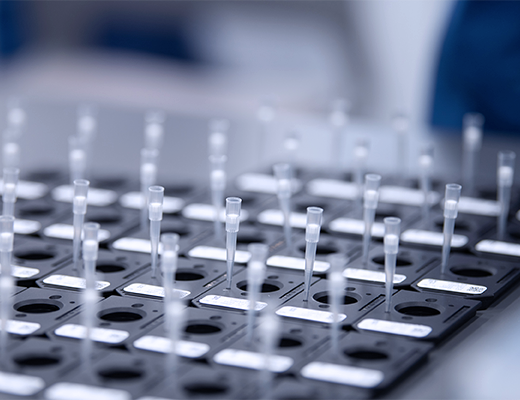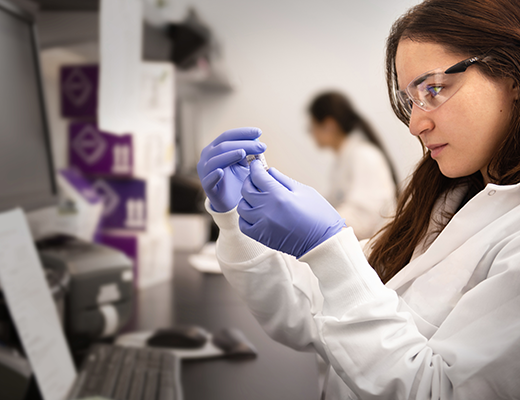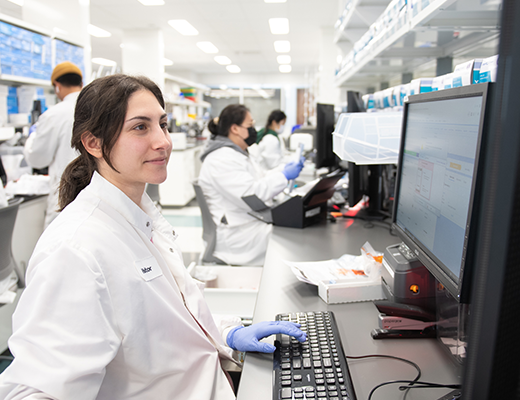

Veracyte’s approach to improving lung cancer diagnosis
Identifying unmet needs through listening and collaboration
At Veracyte, we seek to understand where we can apply cutting-edge technology to best address unmet needs for physicians and their patients. Through our close work with lung cancer physicians and researchers, we knew that low-dose CT scans are highly effective at detecting lung nodules. However, since most lung nodules are not cancerous, their detection can result in unnecessary diagnostic procedures and anxiety for patients. We determined that we could improve care by developing a test that could provide insights to help physicians objectively identify which patients with lung nodules to work up for lung cancer and which patients to simply monitor with imaging.
Veracyte’s Percepta Nasal Swab provides physicians with accurate, objective results that can help guide treatment management for patients with lung nodules. Having access to this simple tool could help shape the future of lung nodule management.”
Medical Director for Pulmonology, Veracyte

EXCEPTIONAL TESTING FOR LUNG NODULE RISK ASSESSMENT
Objectively assessing lung cancer risk in patients with lung nodules using the Percepta® Nasal Swab test
Veracyte’s Percepta Nasal Swab test is a simple, noninvasive tool designed to assess lung cancer risk in patients with lung nodules found on CT scans. The novel test has been shown to identify with high accuracy which patients with lung nodules are low risk for cancer so that they may potentially avoid unnecessary invasive procedures, and which patients are high risk so that they may proceed to further diagnostic work-up and appropriate treatment, if needed.7 The test was developed with RNA whole-transcriptome and machine-learning technology. It utilizes foundational “field of injury” science, which evaluates genomic changes associated with lung cancer that can be found in the nasal passages of current and former smokers.8,9 The Percepta Nasal Swab is currently available to hospitals and clinics that are participating in Veracyte’s NIGHTINGALE trial to assess the impact of its use on patient care.

Learn about our portfolio and test expansion
REFERENCES
Cancer. World Health Organization. Published February 2, 2022. Accessed August 1, 2023. https://www.who.int/news-room/fact-sheets/detail/cancer
Cancer Facts & Figures 2023. American Cancer Society. Accessed August 1, 2023. https://www.cancer.org/content/dam/cancer-org/research/cancer-facts-and-statistics/annual-cancer-facts-and-figures/2023/2023-cancer-facts-and-figures.pdf
New Report: Critically Low Lung Cancer Screening Rates Reveal Opportunity to Save More Lives. American Lung Association. Published November 15, 2022. Accessed August 1, 2023. https://www.lung.org/media/press-releases/state-of-lung-cancer-2022
Gould MK, et al. AJRCCM. 2015.
State of Lung Cancer 2022. American Lung Association. Accessed August 1, 2023. https://www.lung.org/getmedia/647c433b-4cbc-4be6-9312-2fa9a449d489/solc-2022-print-report
Aberle DR. N Engl J Med. 2011.
Lamb C. Oral presentation at CHEST Annual Meeting. October 2021. Virtual format.
Perez-Rogers JF, et al. J Nat Cancer Inst. 2017.
Spira A, et al. Nat Med. 2007.
The Percepta Nasal Swab test is offered in the US as part of Veracyte’s CLIA-validated laboratory developed test (LDT) service. This test has not been cleared or approved by the FDA.
This website contains information on products that are targeted to a wide range of audiences and could contain product details or information otherwise not accessible or valid in your country. Please be aware that we do not take any responsibility for you accessing such information that may not comply with any legal process, regulation, registration or usage in the country of your origin.






